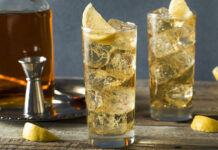Operators must stay ahead of trends and seasonal changes, say drinks firms

MUCH like the seasons, taste in drinks can change throughout the year; what proves popular in the summer may not be selling quite so well as the mercury drops.
Subsequently, it has become vital for outlets to update their cocktail lists in the course of the year to ensure they can appeal to customers with the right flavours at the right time.
This has become even more important as cocktails have become available in more outlets, say drinks firms.
Dan Bolton of Hi-Spirits said operators must keep their cocktail list up to date in order to remain competitive.
“As cocktails become part of more on-trade outlets’ core offer, it turns up the pressure on operators to raise their game and retain a point of difference,” he said.
“Seasonal changes to the cocktail offer are one way to do that.”
But the seasonal switch is “not as straightforward as simply shifting from light to dark spirits”, reckons Bolton.
“For example, gin remains a big seller right across the year and vodka is still the most popular cocktail spirit,” he said.
“However, there is an opportunity to feature seasonal flavours in cocktails with a warming feeling.”
This was echoed by Barry Chalmers, area manager of Signature Pub Group.
He said that a level of seasonality “is of course important as it keeps the menu updated, cost efficient and takes advantage of produce that’s ripe and at its best”.
And he also believes warming flavours are the way to go when curating an autumn/winter cocktail list.
While there should be one or two ‘heavier’ or ‘hot drinks’ on the menu, Chalmers reckons “moving to darker fruits and using spice is an excellent way to suggest a more autumnal or wintery list”.
Taking a similar stance, Alessandro Borelli of Dine Restaurant Edinburgh, speaking on behalf of House of Elrick Gin, said using seasonal fruits not only caters to consumer demand – it makes financial sense too.
Explaining that, for instance, using mangos or papayas during autumn and winter “would cost a fortune”, he advised operators to use typical seasonal fruits, including the likes of apples, pears, quince, and plums.
Keeping a cocktail list attuned to the time of year has a real impact on the bottom line, according to Andrew King of cocktail puree brand Funkin.
He explained that customers “are more willing to trade up to cocktails during key calender occasions”, such as Halloween, and so it’s “important to capitalise on this through relevant and themed serves”.
Other trends to keep in mind include ‘skinny’ cocktails, which King believes are continuing to grow in popularity.
Amy Burgess of Coca-Cola European Partners agreed, stating that “increasingly health conscious consumers are looking for low calorie and low sugar options, but without compromising on taste”.
Another trend to be aware of is consumers’ “increasing sustainability consciousness”, according to Gary Keogh of William Grant & Sons UK.
He explained that more people wish to consume cocktails that make the most of all ingredients, with minimal waste.
“Within the drinks industry, the on-trade is responding with the ‘closed-loop’ cocktail movement making use of ingredients that would have otherwise gone to waste, and more restaurants can be seen championing a zero-waste policy,” said Keogh.
Presentation is another vital component of good cocktails.
Gill Head of glassware firm Artis explained that the right glassware “is an essential part of your drinks presentation”.
“We all ‘feast with our eyes’ before we actually taste – and glassware is probably the most important visual element of a successful cocktail service,” she said.
Operators must also understand that glassware is “a fashion business”, she said, adding that as styles come and go, operators must “keep up with the times in this regard”.
Similarly, Rob Blunderfield of catering equipment firm Parsley in Time said it’s “vital” that cocktail glassware be functional as well as aesthetically pleasing, adding it has “to keep up with peak demand and heavy-duty use”.
Lastly, operators must ensure staff are adequately trained to deliver high quality cocktails.
That was the view of Amy Giacobbi of Continental Wine & Food, who said bartenders “need to be confident in their delivery and know how to make the end result look as well as taste good”.



















